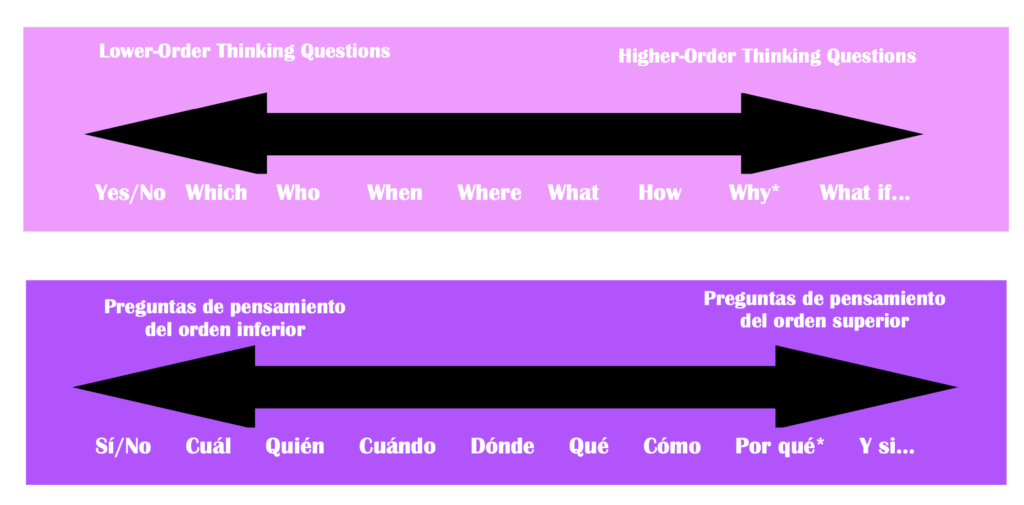You caught a beauty!!!
Download PDF of scaffold here.
theory behind the scaffold…
Higher-order level questions – those that elicit deeper thinking – help students to stretch their thinking and engage their curiosity, their reasoning ability, their creativity, and independence. These questions encourage students to open their minds, they offer opportunities to produce original thinking. A well-structured question….
If we use effective questioning skills in the educational environment, we help our students to be more effective thinkers now and in the future.*
……effective questioning skills can often be the difference between… One of the highly ranked skills wanted by………….. that lead to various solutions of challenging events.

This scaffolding activity uses the question continuum – a range of interrogatories that graduate from lower- to higher-level thinking. The discussions these questions provoke…………………elements that are usually dense, and so very challenging to interpret.
You’ll see that the activity begins with………………………………….
…………….. and are more able to move forward in their learning.
*Zwiers, Jeff & Crawford, Marie (2011). Academic Conversations: Classroom Talk that Fosters Critical Thinking and Content Understandings, USA, Stenhouse Publishers.
**ZPD = Zone of Proximal Development: the distance between the actual developmental level as determined by independent problem solving and the level of potential development as determined through problem solving under adult guidance, or in collaboration with more capable peers” (Vygotsky).
step by step…
- Choose a graph or map from the unit you’re about to begin that might be challenging for your students to understand. In the example below, you’ll see that…………………
NOTE: These maps and graphs probably see simple to us, but …………………………to process the different elements of the map or graph in smaller groups, enables them to consider the information more slowly so that later feel more confident in answering higher-level order questions.
- Formulate questions using the question continuum (above) in order to guide them toward understanding the key elements you’d like them to assimilate.
Example with maps…(they will need to cross reference these maps to answer the questions)

- Do climate maps give you an idea of the seasons of the year a country experiences?
- Which map gives you the names of the countries?
- Who is more likely to live in between 60º and 90º latitude – people who like warm or cold weather? How can you justify your answer?
- When would someone want to visit……………..?
- Where is Europe located – the same latitude as countries located in the temperate zone or………. Justify your answer.
- What are 5 countries in Africa are in the subtropical zone? Which are in the equatorial zone?
- How could you combine these three maps? What information would you need to include in each one?
- Why are there different climates……………..
- What if you could decide where to go for your winter holidays. Which …………………….. and why?
- Formative Evaluation/Reflection: Students write two (2) ……………………………………………….using the Question Continuum.

Other questions you can use with a graph or map in your lessons:
- Do you wonder why…
- Do you think there is a correlation between…
- How do you see the difference between…
- Is there a reason why…
- Did you expect…
- Based on…how do you infer…
- Is this similar to…
- What does the graph not …
- What else can you conclude from these findings?
- How could you present this information in a different way?
- Do you have any other questions you might like ………………..?
- What does the graph not show?
- What else can you ……………….?
- How could you present this information in a different way?
- Do you have any other questions you might like to ask about this information?
video explanation…



Scaffoldingmagic.com is your entryway into DYNAMIC bilingual learning methodologies, such as Phenomenon-Based Learning, CLIL, EMI, and ESL. You’ll find ways to implement critical thinking tools (DOK) to promote higher level thinking, the growth mindset, instill an ethic of excellence, deep reflection on learning, and all through multi-cultural, interdisciplinary activities. We have the keys to turning competences into action and to creating collective efficacy in your school so you move ahead as a unified, enthusiastic team.



